
The leopard is one of the five extant species in the genus Panthera. It has a pale yellowish to dark golden fur with dark spots grouped in rosettes. Its body is slender and muscular reaching a length of 92–183 cm (36–72 in) with a 66–102 cm (26–40 in) long tail and a shoulder height of 60–70 cm (24–28 in). Males typically weigh 30.9–72 kg (68–159 lb), and females 20.5–43 kg (45–95 lb).
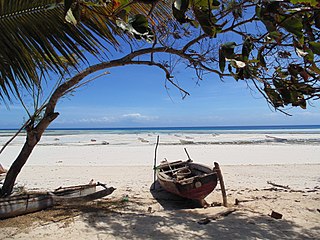
Unguja South Region, Zanzibar South Region or South Zanzibar Region is one of the 31 regions of Tanzania. The region covers an area of 854 km2 (330 sq mi). The region is comparable in size to the combined land area of the nation state of Kiribati. and the administrative region is located entirely on the island of Zanzibar. Unguja South Region is bordered on three sides to the south by Indian Ocean, northeast by Unguja North Region and northwest by Mjini Magharibi Region. The regional capital is the town of Koani. Besides being known for its Spinner dolphin populations, the region is also home to the oldest mosque in East Africa, the Kizimkazi Mosque and also historic Makunduchi town. The region has the fourth highest HDI in the country, making one of the most developed regions in the country. According to the 2022 census, the region has a total population of 195,873.
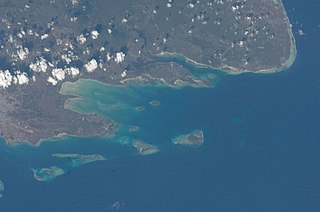
Menai Bay is a bay in Mkinga District of Mjini Magharibi Region of Tanzania. The bay is geogrpahically part of the Zanzibar Archipelago.

The African leopard is the nominate subspecies of the leopard, native to many countries in Africa. It is widely distributed in most of sub-Saharan Africa, but the historical range has been fragmented in the course of habitat conversion. Leopards have also been recorded in North Africa as well.

The servaline genet is a genet species native to Central Africa. As it is widely distributed and considered common, it is listed as Least Concern on the IUCN Red List.

The Arabian leopard is the smallest leopard subspecies. It was described in 1830 and is native to the Arabian Peninsula, where it was widely distributed in rugged hilly and montane terrain until the late 1970s. Today, the population is severely fragmented and thought to decline continuously. Previously in 2008, an estimated 45–200 individuals in three isolated subpopulations were restricted to western Saudi Arabia, Oman and Yemen. However, as of 2023, it is estimated that 100–120 in total remains, with 70-84 mature individuals, in Oman and Yemen, and it is possibly extinct in Saudi Arabia. The current population trend is suspected to be decreasing.
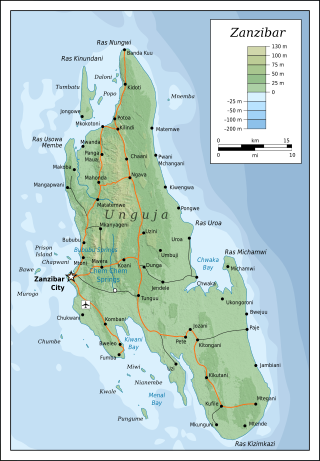
Unguja is the largest and most populated island of the Zanzibar archipelago, in Tanzania.

The Sri Lankan leopard is a leopard subspecies native to Sri Lanka. It was first described in 1956 by Sri Lankan zoologist Paules Edward Pieris Deraniyagala.

The Indian leopard is a subspecies of the leopard that was first scientifically described in 1794. It is widely distributed on the Indian subcontinent. It is threatened by illegal trade of skins and body parts, and persecution due to human-leopard conflict and retaliation for livestock depredation.
The Zanzibar servaline genet is a recently discovered subspecies of servaline genet endemic to Unguja Island in the Tanzanian archipelago of Zanzibar. Its conservation status is uncertain.

Panthera pardus tulliana, also called Anatolian leopard, Persian leopard and Asia Minor leopard, is a leopard subspecies that was first described in 1856 based on a zoological specimen found in western Anatolia. It is native to the Iranian Plateau and the surrounding region from eastern Anatolia and the Caucasus to the Hindu Kush, where it inhabits foremost subalpine meadows, temperate broadleaf and mixed forests and rugged ravines at elevations of 600 to 3,800 m. It preys mostly on ungulates reliant on these habitats.
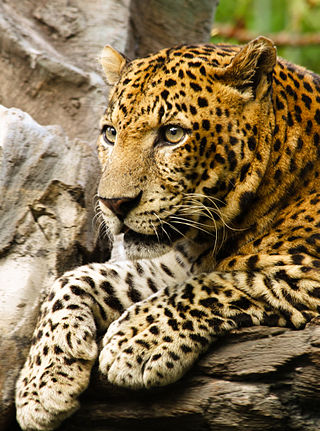
The Javan leopard is a leopard subspecies confined to the Indonesian island of Java. It has been listed as Endangered on the IUCN Red List since 2021. The population is estimated at 188–571 mature individuals in 22 fragmented subpopulations and a declining population trend. The total remaining habitat is estimated at only 2,267.9 to 3,277.3 km2.
Chwaka is a town on the Tanzanian island of Unguja, part of Zanzibar. It is located on the east coast of the island, due east of the capital Zanzibar City, on the coast of Chwaka Bay close to the edge of Jozani-Chwaka Bay National Park.
Jendele is a village on the Tanzanian island of Unguja, part of Zanzibar. It is located in the centre of the island, on the main route between Zanzibar City and Chwaka, to the north of the Jozani-Chwaka Bay National Park.
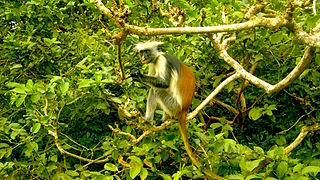
Jozani is a village located in Kusini District of Unguja South Region of the Tanzanian island of Unguja. It is located in the southeast of the island, 3.1 miles south of Chwaka Bay, close to the edge of the Jozani-Chwaka Bay National Park. It is primarily a farming community of about 800 people. located 21.7 miles south-east of Zanzibar Town off the road leading to Paje, Zanzibar. It is easily reached by public buses 309 and 310, by chartered taxi or as an organized tour from Zanzibar Town. These tours are often in combination with dolphin observation in Kizimkazi, one of Zanzibar's oldest settlements with a tiny 12th century mosque open to public. The main road on the island, connecting the west and east coasts of Zanzibar, also connects to Jozani. Besides public bus routes 9, 10 and 13, you can also get here from Zanzibar Town by dala-dala number 309, 310, 324, and 326. Jozani is a small and rural village, situated in the innermost part of the Pete Inlet Bay, immediately south of the Jozani Chwaka Bay National Park. It is one of six rural villages surrounding the park. Residents here depend to a large degree on the Jozani Forest as a source of firewood, hunting, building resources, farming, fishing, and more. The village also operates ecotourism in the Jozani Forest and has constructed a 0.6 mile boardwalk through the mangroves at the southern road entrance into the national park. Many villagers work as authorized guides for tours in the southern tip of Jozani Forest.

The Jozani Chwaka Bay National Park is a 50 km2 (19 sq mi) national park in Tanzania located on the island of Zanzibar. It is the only national park in Zanzibar.

The Amur leopard is a leopard subspecies native to the Primorye region of southeastern Russia and northern China. It is listed as Critically Endangered on the IUCN Red List, as in 2007, only 19–26 wild leopards were estimated to survive in southeastern Russia and northeastern China.

The Indochinese leopard is a leopard subspecies native to mainland Southeast Asia and southern China. In Indochina, leopards are rare outside protected areas and threatened by habitat loss due to deforestation as well as poaching for the illegal wildlife trade. In 2016, the population was previously thought to comprise 973–2,503 mature individuals, with only 409–1,051 breeding adults. The historical range had decreased by more than 90%. However, as of 2019, it is estimated that there are 77-766 mature Indochinese leopards and that their numbers are decreasing.
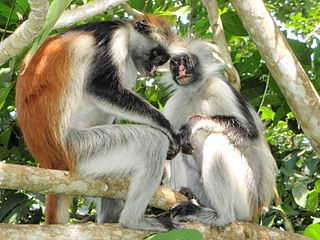
The wildlife of Zanzibar consists of terrestrial and marine flora and fauna in the archipelago of Zanzibar, an autonomous region of Tanzania. Its floral vegetation is categorized among the coastal forests of eastern Africa as the Southern Zanzibar-Inhambane coastal forest mosaic and the Northern Zanzibar-Inhambane coastal forest mosaic. Its faunal species are mostly small animals, birds, and butterflies.

Panthera pardus spelaea, also known as the European Ice Age leopard, is a fossil leopard subspecies which roamed Europe in the Late Pleistocene and possibly the Holocene.

















